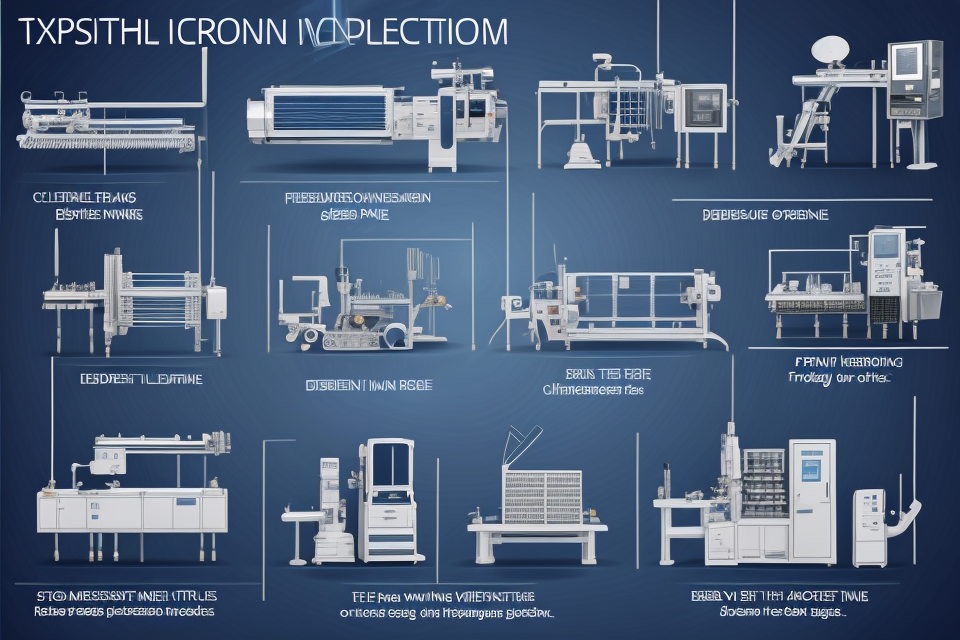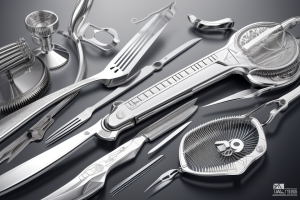
Surgical instruments are an essential part of any medical facility, and their quality and precision can have a significant impact on the success of a surgical procedure. However, many people are unaware of the process behind the manufacturing of these instruments. This guide provides a comprehensive overview of the process of surgical instrument manufacturing, from design to final assembly. Learn about the different materials used, the various manufacturing techniques, and the quality control measures that are taken to ensure the safety and effectiveness of these instruments. Whether you’re a medical professional or simply curious about the inner workings of surgical instrument manufacturing, this guide has something for everyone.
The Basics of Surgical Instrument Manufacturing
The Importance of Surgical Instruments
Surgical instruments play a crucial role in any surgical procedure. They are designed to be precise, durable, and easy to use, allowing surgeons to perform delicate operations with maximum efficiency and minimum risk to the patient. Here are some of the reasons why surgical instruments are so important:
Quality Control
Quality control is a critical aspect of surgical instrument manufacturing. Surgical instruments must be made to precise specifications to ensure that they are safe and effective to use. This means that manufacturers must use high-quality materials and carefully control every stage of the manufacturing process to ensure that the instruments meet the necessary standards. Quality control measures may include visual inspections, functional testing, and microscopic examination of the instruments to ensure that they are free from defects.
Patient Safety
Patient safety is the primary concern of any surgical procedure. Surgical instruments must be designed and manufactured to minimize the risk of infection, injury, or other complications. This means that instruments must be made from materials that are resistant to corrosion and are easy to clean and sterilize. Additionally, instruments must be designed to minimize the risk of lacerations or other injuries to the patient.
Manufacturers must also ensure that the instruments are safe to use for the patient and the medical staff. This includes ensuring that the instruments are designed to be ergonomic and easy to handle, reducing the risk of fatigue or injury to the medical staff. Additionally, manufacturers must provide clear instructions for use and maintenance of the instruments to ensure that they are used safely and effectively.
Overall, the importance of surgical instruments cannot be overstated. They are a critical component of any surgical procedure, and their design and manufacture must be done with the utmost care and attention to detail to ensure patient safety and successful outcomes.
The Different Types of Surgical Instruments
Handheld Instruments
Handheld instruments are the most commonly used surgical instruments and are designed to be held and manipulated by the surgeon during the operation. These instruments are usually made of stainless steel and are sterilized before use. Some examples of handheld instruments include scalpels, scissors, forceps, and clamps.
Table-mounted Instruments
Table-mounted instruments are fixed to the operating table and are not held by the surgeon. These instruments are designed for specific tasks and are used in conjunction with handheld instruments. Examples of table-mounted instruments include electrocautery units, suction and irrigation systems, and surgical lights.
Electrosurgical Instruments
Electrosurgical instruments use electrical energy to cut or coagulate tissue during surgery. These instruments are designed to be used with specialized electrosurgical generators and are used for a variety of procedures, including cutting, coagulation, and fulguration. Examples of electrosurgical instruments include bipolar forceps, monopolar probes, and argon beam coagulators.
The Manufacturing Process
Design and Development
Conceptualization
The process of surgical instrument manufacturing begins with the conceptualization phase. This phase involves the identification of a need for a new surgical instrument or the improvement of an existing one. It is crucial to conduct market research and consult with surgeons and other medical professionals to determine the requirements and specifications of the instrument. This information is then used to develop a concept that addresses the identified needs and is feasible for manufacturing.
Design and Prototyping
Once the concept has been developed, the design phase commences. This phase involves creating detailed drawings and specifications of the instrument. Computer-aided design (CAD) software is commonly used to create 3D models of the instrument, which can be reviewed and modified as necessary. Prototypes are then manufactured to test the design and ensure that it meets the specified requirements.
The prototyping phase is critical as it allows for the identification and correction of any design flaws before mass production. Different materials can be tested to determine which is most suitable for the instrument. The prototypes are also subjected to various tests to evaluate their functionality, durability, and performance.
Testing and Validation
After the prototypes have been manufactured and tested, the testing and validation phase begins. This phase involves evaluating the performance of the instrument in various scenarios and conditions. The instrument is tested for its accuracy, precision, and efficiency. It is also subjected to various simulations to assess its performance in different surgical procedures.
In addition to the performance tests, the instrument is also evaluated for its safety and biocompatibility. This involves testing the instrument for any potential adverse reactions or complications that may arise during use.
Overall, the testing and validation phase is crucial in ensuring that the instrument meets the required standards and specifications for surgical instrument manufacturing. It is only after this phase that the instrument is ready for mass production and commercialization.
Material Selection and Preparation
Material Choices
The selection of materials for surgical instruments is critical as it affects the performance, durability, and safety of the instruments. Stainless steel is a popular choice due to its corrosion resistance, strength, and low cost. Titanium is also used due to its high strength-to-weight ratio and biocompatibility. Other materials include aluminum, plastic, and ceramic.
Surface Treatments
Surface treatments are used to improve the performance and longevity of surgical instruments. Common treatments include anodizing, plating, and coating. Anodizing creates a protective layer on the surface of the metal, while plating adds a layer of another metal to improve durability. Coating can be applied to enhance the instruments’ lubricity, reduce friction, or improve the visibility of the instruments under x-rays.
Sterilization
Sterilization is an essential step in the manufacturing process to ensure that the instruments are free from bacteria and other microorganisms. The most common sterilization methods include steam sterilization, ethylene oxide sterilization, and radiation sterilization. Each method has its advantages and disadvantages, and the choice of sterilization method depends on the type of instrument and the intended use.
In summary, the material selection and preparation stage of surgical instrument manufacturing involves choosing the appropriate materials for the instruments, applying surface treatments to improve their performance, and ensuring that the instruments are sterilized to prevent infection. These steps are crucial to producing high-quality surgical instruments that are safe and effective for medical professionals to use.
Production and Assembly
Parts Sourcing
Parts sourcing is a crucial aspect of surgical instrument manufacturing. High-quality raw materials must be sourced to ensure the durability and effectiveness of the final product. This involves identifying and selecting suppliers who can provide the necessary materials, such as stainless steel, titanium, and plastic. The materials must meet specific standards and regulations set by the industry, such as ISO 10993 for biocompatibility.
Parts Assembly
Once the raw materials have been sourced, the next step is to assemble the individual parts. This may involve cutting, bending, and shaping the materials to the desired shape and size. The parts are then cleaned and inspected for defects before being moved to the next stage of assembly.
Final Assembly
Final assembly is the stage where all the individual parts come together to form the complete surgical instrument. This involves attaching the handles, blades, and other components to the main body of the instrument. The final product is then inspected for functionality and performance before being packaged and shipped to the customer.
Overall, the production and assembly stage of surgical instrument manufacturing is a complex process that requires precision and attention to detail. By carefully sourcing the highest quality materials and assembling the parts with care, manufacturers can produce surgical instruments that are safe, effective, and long-lasting.
Quality Control and Testing
Visual Inspection
Visual inspection is a critical aspect of quality control in surgical instrument manufacturing. This process involves a thorough examination of the instrument for any defects or imperfections that may affect its performance or safety. Visual inspection is typically performed by trained technicians who are experienced in identifying defects that may not be immediately apparent.
During visual inspection, the instrument is examined for any visible signs of damage, such as cracks, dents, or corrosion. The technician will also check for any inconsistencies in the finish or color of the instrument, as these may indicate a problem with the manufacturing process. In addition, the technician will ensure that all labels and markings on the instrument are accurate and legible.
Functional Testing
Functional testing is another important aspect of quality control in surgical instrument manufacturing. This process involves testing the instrument to ensure that it functions as intended and meets the necessary performance standards. Functional testing is typically performed using specialized equipment that simulates the conditions in which the instrument will be used.
During functional testing, the instrument is subjected to various tests to evaluate its performance. For example, the instrument may be tested for accuracy, precision, and repeatability. The instrument may also be tested for durability, to ensure that it can withstand the stresses and strains of repeated use.
In addition, functional testing may involve testing the instrument’s components, such as blades or cutting edges, to ensure that they are sharp and functional. The instrument may also be tested for ease of use and ergonomics, to ensure that it is comfortable and easy to handle for the surgeon.
Performance Testing
Performance testing is the final stage of quality control in surgical instrument manufacturing. This process involves testing the instrument under actual operating conditions to ensure that it performs as intended in a real-world setting. Performance testing is typically performed by surgeons or other medical professionals who are familiar with the instrument’s intended use.
During performance testing, the instrument is used in a simulated surgical procedure to evaluate its performance. The surgeon will assess the instrument’s performance in terms of its ease of use, accuracy, precision, and overall effectiveness. The instrument may also be compared to other instruments to evaluate its performance relative to other options available on the market.
Performance testing is critical to ensuring that the instrument meets the necessary performance standards and is safe for use in surgical procedures. It is also an opportunity to identify any issues or problems that may arise during actual use, allowing for modifications or improvements to be made before the instrument is released for use in actual surgical procedures.
Packaging and Distribution
Packaging
The packaging of surgical instruments is a critical aspect of the manufacturing process. The packaging must be designed to protect the instruments during transportation and storage while also providing easy access to the instruments when needed.
Surgical instruments are typically packaged in hard cases made of materials such as polypropylene or ABS plastic. These cases are designed to provide maximum protection against impact and vibration, ensuring that the instruments arrive at their destination in the same condition as they left the manufacturer.
In addition to the hard case, the instruments may also be packaged in soft pouches or bags. These pouches or bags are made of materials such as nylon or polyester and are designed to provide a protective barrier against dirt, moisture, and other environmental factors.
Distribution
Once the surgical instruments have been packaged, they are ready for distribution. The distribution process involves getting the instruments to the end-user, which can be a hospital, clinic, or other medical facility.
The distribution process is typically handled by specialized logistics companies that have experience in handling medical equipment. These companies have the expertise to ensure that the instruments are transported safely and arrive at their destination in good condition.
During the distribution process, the instruments are tracked to ensure that they arrive at their destination on time and in good condition. The instruments are also inspected upon arrival to ensure that they are in proper working order and that all components are included.
Overall, the packaging and distribution process is a critical aspect of the surgical instrument manufacturing process. The packaging must be designed to protect the instruments during transportation and storage, while the distribution process must be handled by specialized logistics companies to ensure that the instruments arrive at their destination in good condition.
The Future of Surgical Instrument Manufacturing
Emerging Technologies
3D Printing
One of the most promising emerging technologies in surgical instrument manufacturing is 3D printing. This technology allows for the creation of custom-designed surgical instruments that can be tailored to meet the specific needs of individual patients. This is particularly beneficial in complex surgeries where traditional instruments may not be suitable. 3D printing also allows for the rapid prototyping and iteration of new instrument designs, reducing the time and cost associated with traditional manufacturing methods.
Robotics
Robotics is another emerging technology that has the potential to revolutionize surgical instrument manufacturing. Robotic systems can be used to automate many of the tasks involved in the manufacturing process, such as cutting, shaping, and finishing. This can improve accuracy, efficiency, and consistency, reducing the risk of human error and improving overall product quality. Robotics can also be used to create instruments with complex geometries and shapes that would be difficult or impossible to manufacture using traditional methods.
Material Science
Advancements in material science are also playing a key role in the future of surgical instrument manufacturing. New materials with unique properties, such as biocompatibility, flexibility, and durability, are being developed and integrated into surgical instruments. These materials can improve the performance and safety of instruments, reduce the risk of complications during surgery, and improve patient outcomes. In addition, advances in coatings and surface treatments are allowing for the creation of instruments that are easier to clean and sterilize, reducing the risk of infection.
The Impact on Healthcare
Improved Efficiency
The advancements in surgical instrument manufacturing have led to increased efficiency in healthcare facilities. The improved design and functionality of surgical instruments have enabled surgeons to perform procedures more quickly and accurately, resulting in less patient downtime and faster recovery times. This efficiency translates to cost savings for healthcare providers and improved outcomes for patients.
Enhanced Patient Safety
The future of surgical instrument manufacturing is focused on enhancing patient safety. Advancements in materials science and engineering have led to the development of surgical instruments that are more durable, corrosion-resistant, and sterilizable. These features reduce the risk of patient infection and improve the overall safety of surgical procedures. Additionally, the incorporation of sensors and robotics in surgical instruments has enabled surgeons to perform minimally invasive procedures with greater precision, reducing the risk of complications.
Personalized Medicine
Personalized medicine is a growing trend in healthcare, and surgical instrument manufacturing is playing a critical role in its development. Advancements in 3D printing and additive manufacturing have enabled the creation of customized surgical instruments that are tailored to the specific needs of individual patients. This personalized approach to surgery allows for more precise and effective treatment, resulting in better patient outcomes and reduced healthcare costs. Furthermore, the data generated from the use of these instruments can be used to improve surgical techniques and develop new treatments.
FAQs
1. What is the process of surgical instrument manufacturing?
The process of surgical instrument manufacturing involves several steps, including design, prototyping, tooling, and production. The instruments are designed to meet specific requirements and specifications, and then prototypes are created to test and refine the design. Tooling is then made to produce the final product, and the production process begins.
2. What materials are used in surgical instrument manufacturing?
Surgical instruments are typically made from stainless steel, titanium, or plastic. These materials are chosen for their durability, sterilizability, and resistance to corrosion. Some instruments may also include components made from other materials, such as ceramics or silicone, depending on the specific requirements of the instrument.
3. How are surgical instruments sterilized?
Surgical instruments are typically sterilized using a method called autoclaving. This process involves placing the instruments in a chamber and subjecting them to high pressure and heat to kill any bacteria or other microorganisms that may be present. Some instruments may also be sterilized using other methods, such as gamma radiation or ethylene oxide.
4. How long do surgical instruments last?
The lifespan of surgical instruments can vary depending on factors such as the material they are made from, the frequency of use, and how well they are maintained. In general, high-quality surgical instruments can last for many years if they are properly cared for and maintained.
5. What types of surgical instruments are there?
There are many different types of surgical instruments, including scalpels, scissors, forceps, retractors, and clamps. Each instrument is designed for a specific purpose and is made to precise specifications to ensure that it functions properly. Some instruments are used for cutting or dissecting tissue, while others are used to hold or manipulate tissue during surgery.
6. How are surgical instruments cleaned and maintained?
Surgical instruments should be cleaned and maintained regularly to ensure that they function properly and to extend their lifespan. This typically involves cleaning the instruments with a mild detergent and then rinsing them with water. They may also be sterilized using a method such as autoclaving, and then stored in a sterile or clean environment. Regular maintenance, such as oiling moving parts, may also be necessary to keep the instruments in good working order.







